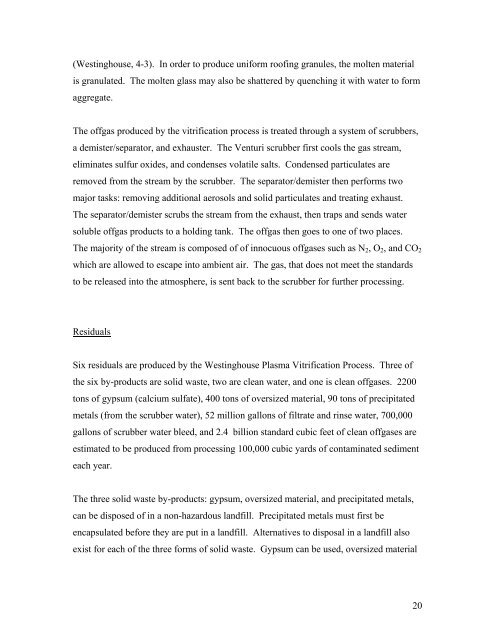New York/ New Jersey Harbor: Alternative Methods for Ex ... - CLU-IN
New York/ New Jersey Harbor: Alternative Methods for Ex ... - CLU-IN
New York/ New Jersey Harbor: Alternative Methods for Ex ... - CLU-IN
Create successful ePaper yourself
Turn your PDF publications into a flip-book with our unique Google optimized e-Paper software.
(Westinghouse, 4-3). In order to produce uni<strong>for</strong>m roofing granules, the molten material<br />
is granulated. The molten glass may also be shattered by quenching it with water to <strong>for</strong>m<br />
aggregate.<br />
The offgas produced by the vitrification process is treated through a system of scrubbers,<br />
a demister/separator, and exhauster. The Venturi scrubber first cools the gas stream,<br />
eliminates sulfur oxides, and condenses volatile salts. Condensed particulates are<br />
removed from the stream by the scrubber. The separator/demister then per<strong>for</strong>ms two<br />
major tasks: removing additional aerosols and solid particulates and treating exhaust.<br />
The separator/demister scrubs the stream from the exhaust, then traps and sends water<br />
soluble offgas products to a holding tank. The offgas then goes to one of two places.<br />
The majority of the stream is composed of of innocuous offgases such as N2, O2, and CO2<br />
which are allowed to escape into ambient air. The gas, that does not meet the standards<br />
to be released into the atmosphere, is sent back to the scrubber <strong>for</strong> further processing.<br />
Residuals<br />
Six residuals are produced by the Westinghouse Plasma Vitrification Process. Three of<br />
the six by-products are solid waste, two are clean water, and one is clean offgases. 2200<br />
tons of gypsum (calcium sulfate), 400 tons of oversized material, 90 tons of precipitated<br />
metals (from the scrubber water), 52 million gallons of filtrate and rinse water, 700,000<br />
gallons of scrubber water bleed, and 2.4 billion standard cubic feet of clean offgases are<br />
estimated to be produced from processing 100,000 cubic yards of contaminated sediment<br />
each year.<br />
The three solid waste by-products: gypsum, oversized material, and precipitated metals,<br />
can be disposed of in a non-hazardous landfill. Precipitated metals must first be<br />
encapsulated be<strong>for</strong>e they are put in a landfill. <strong>Alternative</strong>s to disposal in a landfill also<br />
exist <strong>for</strong> each of the three <strong>for</strong>ms of solid waste. Gypsum can be used, oversized material<br />
20
















